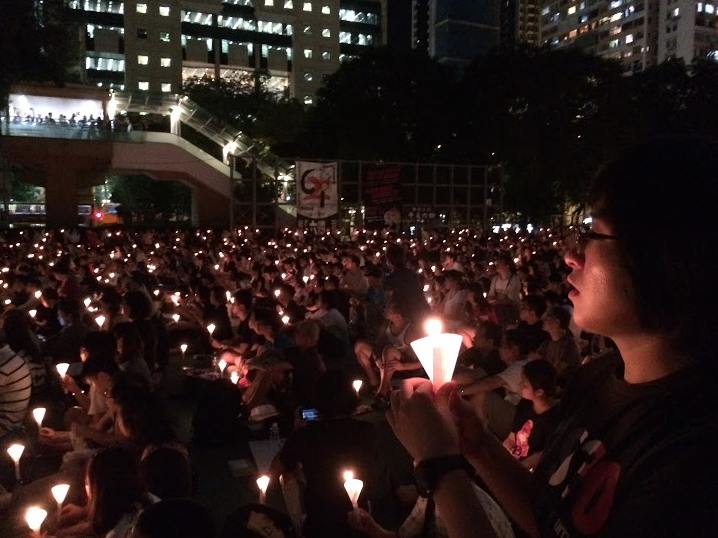 |
June 4, 2015 at Hong Kong’s Victoria Park (Photo by the author) |
Last year, the twenty-fifth anniversary of the 1989 Tiananmen student movement and its brutal crackdown made major headlines. China-watchers, journalists, and academics commemorated June 4—as the event is called for short—with articles and books, and with lectures and roundtables. Here in Hong Kong, the former British colony and now Chinese special administrative region, an estimated 180,000 people turned out for a vigil.
The commemoration is organized yearly by the Hong Kong Alliance in Support of Patriotic Democratic Movements in China, a group that also established the first and only museum about June 4. Thus in the sole place in China where Tiananmen can be remembered, in 2014 locals participated in a familiar ritual: they gathered on the fields of Victoria Park, they lit candles from one to another, they sang songs, and they bowed three times in unison to a monument for the martyred.
In many ways, this year the Tiananmen vigil followed similar patterns. Up at Chinese University where I teach, students had draped the archway in front of the library with the slogan “vindicate June 4” ( pingfan liusi), a reference to the Communist Party judgment that the participating students were counterrevolutionaries rather than patriots. In the waning light of the afternoon current students walked towards the subway with the flags of the university’s colleges.
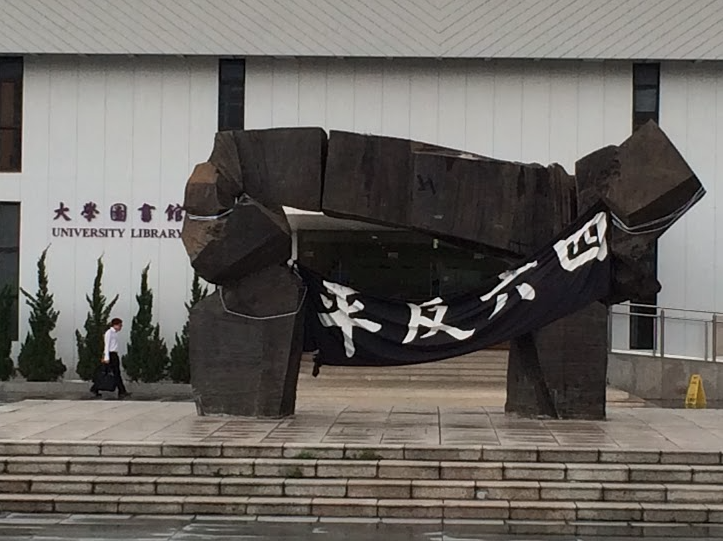 |
A black banner with the slogan “vindicate June 4” before the Chinese University of Hong Kong’s library (Photo by the author) |
At the Causeway Bay station people of all ages were dressed in black, and the street leading to Victoria Park was as usual a gauntlet of political parties and interest groups, offering pamphlets and selling t-shirts. Just like last year, Leung “Longhair” Kwok-hung from the League of Social Democrats was jumping up and down and shouting. When I left three hours later it was the same refrain, “Donate, donate, donate, donate!” My photographs from this year, the unremarkable twenty-sixth anniversary, look much like the last.
And yet this year is consciously different.
The numbers are down to an estimated 135,000 people and part of this has been attributed to two alternate events: a commemoration held at the University of Hong Kong and a rally in the Tsim Sha Tsui area that was virulently anti-China. What was the cause of this fracture?
A bit of background: in 1989 when Tiananmen happened, Hong Kong was still part of the British empire. The premise of the Hong Kong Alliance and others in favor of the 1997 handover of Hong Kong to China was that Hong Kongers would promote democracy in China, setting the example for political change.
But though it was understood that Hong Kong would be allowed to maintain its freedoms and institutions post-1997, over the last few years Hong Kong has seen the gradual erosion of such hopes.
Over three months at the end of 2014, thousands of people took to the streets during the Occupy Central/Umbrella Movement to protest a Beijing ruling that the so-called “universal suffrage” for the next Hong Kong Chief Executive will be limited to a slate of hand-picked candidates loyal to China.
 |
Umbrella Movement protestors stream through the Admiralty district on October 1, 2014, National Day. (Photo by author) |
In the wake of Umbrella, the localist movement that shunned the Tiananmen vigil this year makes the following argument: Hong Kong should focus on its own democracy; China’s politics are not her concern.
Against these divisions, this year’s Tiananmen vigil was all about the Umbrella Movement.
In the street outside Victoria Park some held signs with its slogans, “I want true universal suffrage,” others offered yellow umbrellas and wristbands for sale, and the pamphleteering was dotted with Umbrella Movement references. Paper fans from the Democratic Party called on Hong Kongers to “Continue to Raise [the Umbrella],” a newsletter from the League of Social Democrats juxtaposed the public art piece “Umbrella Man” with Tiananmen’s Goddess of Democracy, and a free glossy children’s book featured forest animals using their umbrellas as shields against bulldog policemen throwing canisters of tear gas.
Joining the familiar battery of politicians was Joshua Wong, the founder of Scholarism (the Hong Kong pro-democracy student activist group) and the Umbrella Movement’s most-recognized student face. The logo for the Tiananmen vigil itself is explicit: a lit candle in its paper holder is also a yellow umbrella whose handle forms the “6” of “6-4,” or June 4th.
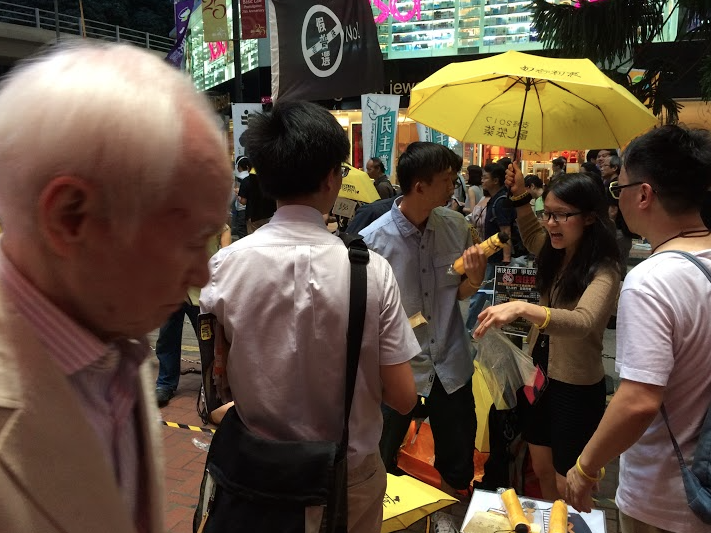 |  |
Yellow umbrellas for sale; signs call for the return to the Admiralty protest site, resistance against mainland-ization, and “I want true universal suffrage” (Photos by the author) | |
Inside Victoria Park and during the vigil, these visual links were bound even closer. Almost everything on the program included the Umbrella Movement, from the video of Tiananmen participant Wang Chaohua who praised the Hong Kong students to the four speeches by Hong Kong student union leaders.
Moments after Hong Kong Alliance and student representatives lit a torch of remembrance for Tiananmen’s victims, they concluded their speeches by tearing copies of Hong Kong’s constitution, the Basic Law, and lighting its pages with the flame. Later in the evening, attendees paid tribute to the people in China who were arrested for expressing support for Umbrella. The word some speakers used was “compatriot” (tongbao), which literally means to share the same womb.
The theme song of the Umbrella Movement, “Raise the Umbrella,” was part of the vigil, and perhaps the traditional Tiananmen song, “Flowers of Freedom” could be sung with a Chinese critique. Instead of the “China Dream” that is the mainland’s latest propaganda watchword, the chorus of “Flowers of Freedom” repeats, “but there is a dream, a dream that cannot die, remember this!/From the hearts of you and I, remember this!”
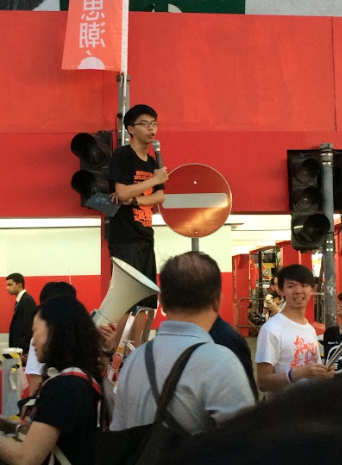 | 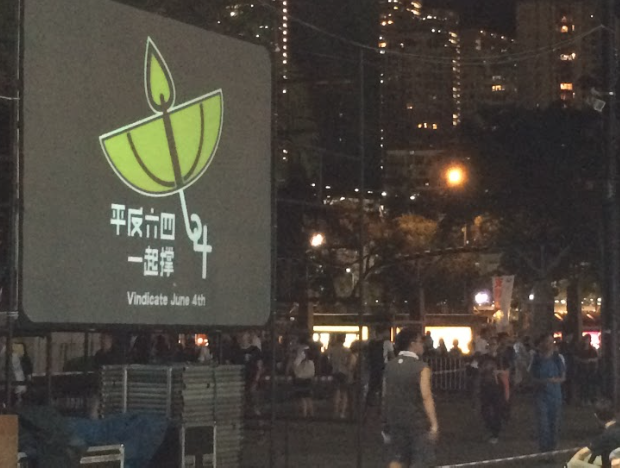 |
Joshua Wong at the microphone; and the logo for the Tiananmen vigil (Photos by the author) | |
Remembrance thus strikes at the heart of who makes up “you and I.” Being from Hong Kong has long been caught up in the difference between identifying as culturally Chinese and politically Chinese.
Two generations ago, advocating for reunification made these one and the same. Though not pro-Communist, this “Chinese” meant that Hong Kong was part of the Chinese nation. For the next, one might be “Hong Kong Chinese,” Hong Kong first and Chinese second.
The current generation that calls itself “Hong Kongers” (Xianggangren or Gangren) is divided. A localist strain rejects Chinese politics as its own; it is not its brother’s keeper. For the remainder, of those who still attend the vigil, it means many things.
They may come to mourn the memory of Tiananmen itself, for who will remember but for Hong Kong? They may light candles because they see commemoration as a way to “Raise the Umbrella.” And they may remember not just that both movements were led by students and called for democracy, but that they stood to face the same Party-state.
